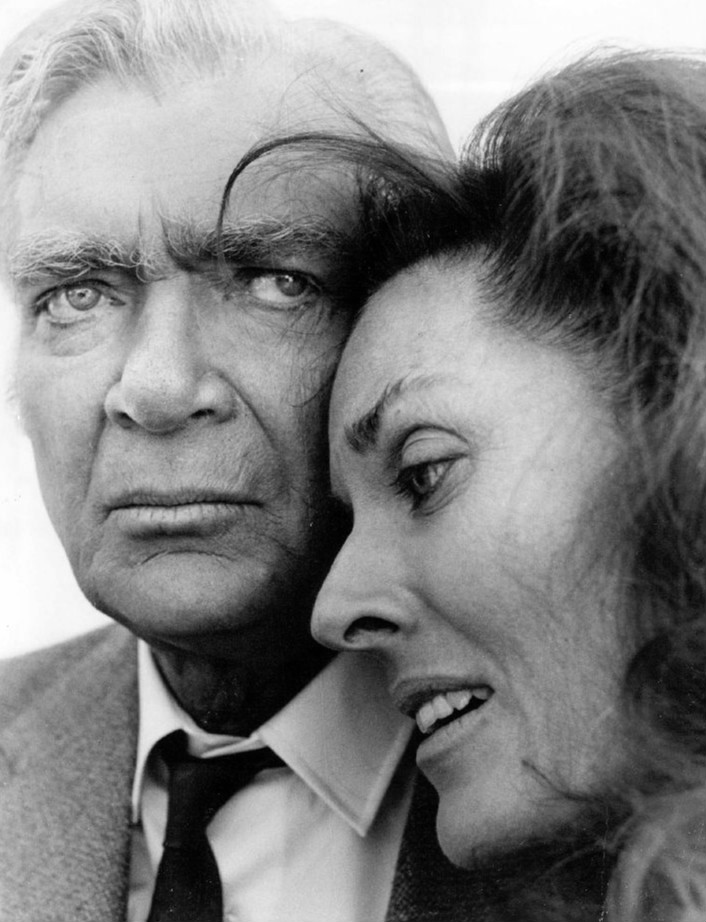Essayist and short story writer Kevin Mims has contributed posts to this site on a number of different topics. This time he offers some thoughts about a classic, but sometimes overlooked, TV crime drama. You may want to revisit the series after reading this if you saw it years ago—or tune in for the first time if you’re too young to have watched it when it aired. —Janet Hutchings

When people discuss the prestige TV crime dramas of the 1970s, they tend to mention Columbo, The Rockford Files, Kojak, The Streets of San Francisco, Police Story, McCloud, and McMillan and Wife. Sometimes they also throw in Starsky and Hutch, Baretta, and Angie Dickinson’s groundbreaking Police Woman. One show that doesn’t get enough attention from genre aficionados is Barnaby Jones, a Quinn Martin production that starred Buddy Ebsen and Lee Meriwether and ran on CBS TV from 1973 to 1980, for a total of 178 episodes. The Rockford Files, one of the most highly regarded TV detective shows of all time, notched a total of 123 episodes (later augmented by 8 TV movies scattered over five years in the 1990s). Likewise, Peter Falk’s iconic Columbo character appeared in only 45 canonical episodes of that program between 1971 and 1978. After a decade-long hiatus the character was resurrected, less successfully, for an additional 24 episodes, which aired on ABC TV between 1989 and 2003. Even among Quinn Martin productions, Barnaby Jones was exceptional. The Streets of San Francisco and Cannon, both Quinn Martin productions of the 1970s, ran for a total of 121 and 122 episodes respectively.
Of course, longevity alone isn’t always a sign of a high-quality TV series. Some mediocre programs seem to last forever. And some very good programs get cancelled far too prematurely. Crime novelist Max Allen Collins has called City of Angels, starring Wayne Rogers, “the best private eye series ever.” It debuted in February of 1976 and was cancelled in May, after a run of just 13 episodes. The fact that Barnaby Jones ran for eight seasons tells us that it was popular but not that it was necessarily a good show.
The series came along at a time when network television was focused on a 1970s version of what we nowadays call “inclusion.” These days, inclusion, when applied to television, generally refers to an effort to highlight stories featuring racial minorities, LGBTQ people, women, and others whose stories tended, in the past, to be overshadowed by the stories of heroic white, heterosexual males. In the late 1960s and the 1970s, TV networks made an effort to give their viewers heroes who weren’t necessarily ideal physical specimens (though they were all still very much white, heterosexual, and male). Thus, we got Ironside (starring Raymond Burr), a show about a San Francisco police chief who is confined to a wheelchair. We also got Longstreet (starring James Franciscus), about a blind New Orleans insurance investigator. We got Baretta (starring 5’ 4” Robert Blake) about a short detective. We got Cannon (starring William Conrad), which featured an obese private detective. And we got Barnaby Jones, which was about a senior-citizen detective. Buddy Ebsen was a few months shy of 65 when the program debuted in January of 1973. The final episode aired on April 3, 1980, one day after Ebsen’s 72nd birthday.
The series began with a crossover episode that also featured William Conrad’s Cannon character. In the opening episode, Barnaby Jones is a retired private eye (and a one-time college science teacher). He comes out of retirement to investigate the murder of his son, Hal, who was also a private eye and a colleague of Frank Cannon’s. Together, Barnaby and Cannon bring Hal’s killer to justice. At the end of the episode, Barnaby decides that he wants to become a full-time detective again. He hires his widowed daughter-in-law, Betty (played by Lee Meriwether), to run his office.
Many of the most successful TV crime series of the 1970s employed a gimmick or two that set them apart from the rest. Columbo, for instance, had numerous such gimmicks. Foremost among these was the format. Each episode began with a murder being committed. The viewer always knew who the killer was. Columbo wasn’t a whodunit. The pleasure came from watching Columbo develop a rapport with his chief suspect as he slowly reeled him in. What set The Rockford Files apart from other detective shows was its humor. Columbo contained plenty of humor, but it was light on violence and action, so the humor didn’t seem out of place. The Rockford Files, on the other hand, had plenty of car chases, shootouts, fistfights, and other hallmarks of the violent TV detective show. The humor in Rockford seemed more subversive than the humor in Columbo, because Rockford often employed it just as he was about to be beaten to a pulp by some thug, or as he was being led off in handcuffs by some overzealous police officer. Police Woman was distinguished by the fact that its tough-guy cop was actually a female police detective. Kojak tried to distinguish itself from the pack by bringing gritty, realistic detail to its stories of crime on the streets of New York City. By comparison with these programs Barnaby Jones was fairly conventional. The writers of the show didn’t emphasize the character’s age much, and Barnaby regularly engaged in the kind of action-hero antics—car chases, shoot-outs, even karate chops—that were commonplace on TV crime dramas of the era. One thing that did distinguished Barnaby from the other detectives was his interest in forensics. His office was equipped with a laboratory where he regularly examined things—blood, dirt, fabrics, paint, etc.—under a microscope. He also had a darkroom, where he could develop his own photographs. He was ahead of the curve here. By the end of the twentieth century, forensics would be all the rage in crime dramas, not just on television but also on the big screen and in many a series of crime novels. But when Barnaby Jones debuted back in 1973, forensics generally took a back seat to shoot-outs and fisticuffs.
Columbo was noteworthy for the high quality of its guest stars. But many of Columbo’s most memorable guest stars also guest starred on Barnaby Jones, including Jack Cassidy, Ross Martin, Susan Clark, Roddy McDowell, Patrick O’Neal, Ida Lupino, and William Shatner. What’s more, the writers of Barnaby Jones weren’t required to employ any specific storytelling formula. Sometimes you knew from the first act who the killer was and how he did it. Sometimes these things were not revealed until the final act. Thus, when they wanted to, the writers of Barnaby Jones were free to employ the Columbo formula. Many Barnaby Jones episodes begin by showing us exactly who the killer is and how he committed the crime. Then, like Columbo, Barnaby shows up and begins slowly unraveling the villain’s perfect crime. By the time Barnaby Jones debuted, Columbo was the most highly-regarded crime show on TV, so it makes sense that Quinn Martin and company might have wanted to borrow a few pages from the Columbo playbook now and then.
It is a tribute to Ebsen’s acting skills that he was able to make a success of Barnaby Jones. From 1962 to 1971, he starred as Jed Clampett in The Beverly Hillbillies, one of the most commercially successful TV shows of its era. Jed Clampett was a hick from Tennessee who somehow managed to make a fortune, which allowed him to move to Beverly Hills, California, where he thrived as a fish-out-of-water among his much more sophisticated and refined neighbors. Very few TV actors of the era were able to escape being typecast after portraying an iconic character in a sitcom. None of the actors in Gilligan’s Island went on to break out of their comic mold. Don Adams, Barbara Felton, and Ed Platt, who starred in Get Smart, all saw their careers peter out after the show went off the air. Things got so bad for Ed Platt that he committed suicide in 1974 at the age of 58, having failed to resume the film career that he left in order to take on a role in a sitcom. Shrewdly, the creators of Barnaby Jones had Ebsen’s character often pretending to be just another down-home country boy like Jed Clampett. Ebsen’s Jones liked to assume an “aw shucks” manner in order to lull his prey into a false sense of intellectual superiority over him. Barnaby Jones claims (believably) to have been born and raised in North Carolina, and Ebsen gives the character a comfortably folksy geniality most of the time.
It must be conceded that the mysteries on Barnaby Jones are generally not all that clever or absorbing. The killers and victims generally have very little in the way of back-story. This was true of most of the crime dramas of the era. But among the things that set the show apart from most of its competitors were the homespun pieces of wit and wisdom that Barnaby was forever spouting to his listeners. Those alone make the program worth watching. Some of these possessed the mysterious quality of a Zen koan. Some of them feel like they might have come out of Poor Richard’s Almanac. And others feel like something your grandfather might have told you when you were just young’un yourself. Here are just a few examples of the wit and wisdom of Barnaby Jones.
“When one egg gets broken you blame the chicken. When they’re all broken you get the feeling there has been a fox in the hen house.”
“It takes more than age to make an antique.”
“When you don’t know what you’re looking for, it doesn’t hurt to look everywhere.”
“Sometimes a man has to gamble with what he hasn’t got.”
“Even a young possum knows enough to tell when it’s been treed.”
“It doesn’t take courage to commit murder, just a particular kind of cowardice.”
“The great thing about each day is that nobody has ever used it before. It’s fresh and you can do what you want with it.”
“Never try to bury the truth. It has a sneaky way of coming back to haunt you.”
“The only thing that’s a cinch is the strap on a saddle.”
“Love is the most misused four-letter word around.”
“Bananas and grapes may come in bunches but not coincidences.” All eight seasons of Barnaby Jones are currently available for streaming on Amazon Prime. My wife and I have been bingeing them for a month or so now. When the show debuted in 1973 I was fourteen years old and Barnaby Jones struck me as sort of a dull old fuddy-duddy. I couldn’t understand the program’s popularity. I preferred rugged tough guys like Mannix, and Rockford, and Baretta. Now the character seems filled with hard-won intelligence and amazing insights into human foibles and frailties. I suspect those qualities were always there in Ebsen’s performance. They’ve just been waiting for me to grow wise enough to appreciate them.


I love Barnaby Jones, I’m 60 yrs young and I still watch him and Mannix, Cannon, love those guys.
Television was good to WATCH then.
Oddly, you don’t mention Mark Shera as Jedidiah Romano…J.R.Jones. What gives?
Talk about informative and a wee bit of historical truths, this article had me looking further into Barnaby Jones. I wake up at 3AM to watch it on ME TV. The episode called The Judgment is my favorite.